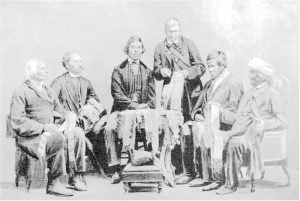St. Regis Colony
This passage is a historical account of the St. Regis Colony, a community of Iroquois people who converted to Catholicism in the 17th and 18th centuries. The author traces the origins of the colony to French missionary efforts and the political maneuvering of the French monarchy, which sought to expand its influence in North America at the expense of the British. The St. Regis community, composed primarily of Mohawks, was seen as a strategic asset by the French and was encouraged to separate from the main Iroquois Confederacy. This separation led to tensions and resentment between the St. Regis community and the other Iroquois tribes, who viewed them as outsiders and collaborators with the French. The author highlights the role of the St. Regis Colony in the French and Indian War and the American Revolution, emphasizing its actions as a source of conflict and suffering for frontier settlements. Finally, the passage concludes by describing the St. Regis population and its division between Canada and the United States as a result of the Treaty of Ghent.


